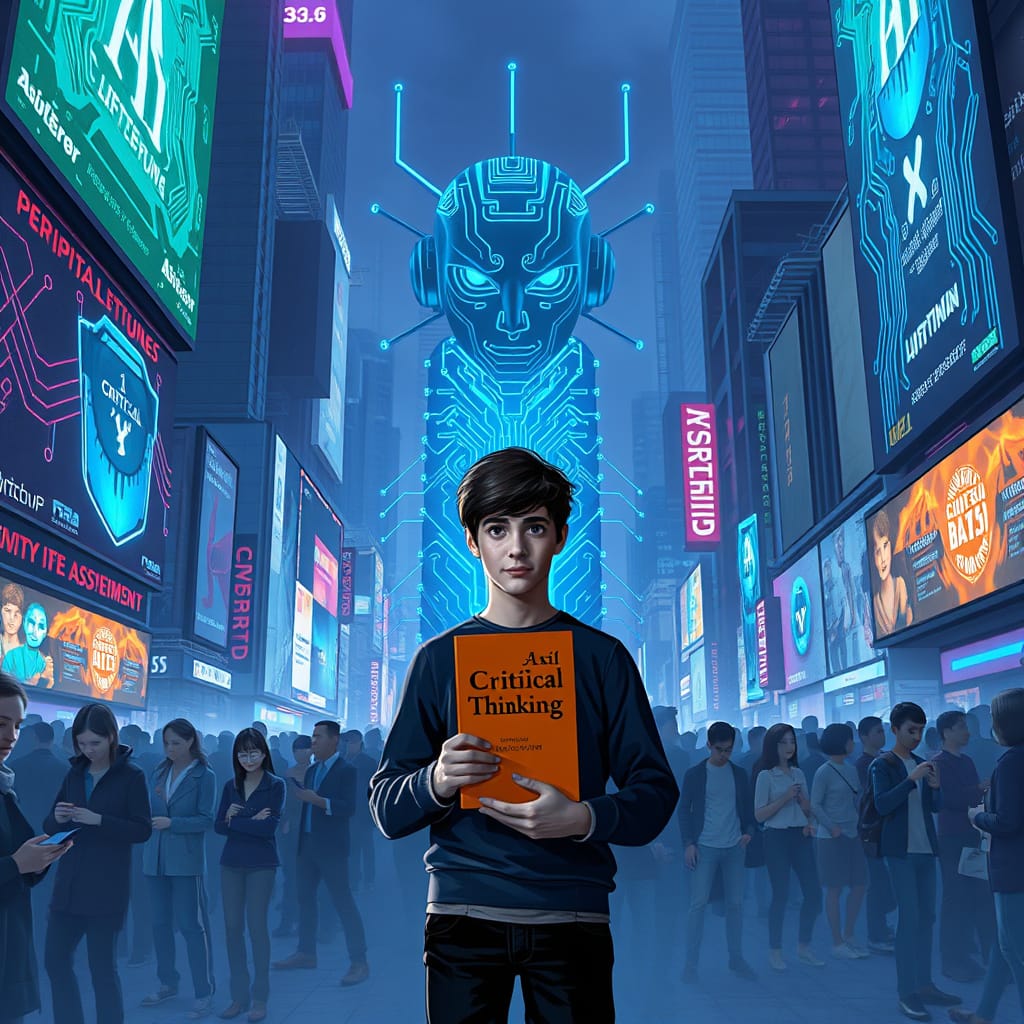Down the rabbit hole of artificial intelligence development, where logic twists like a Möbius strip and common sense becomes as elusive as a Cheshire Cat’s grin, a most peculiar revelation has emerged from the looking glass of Silicon Valley. The path to artificial general intelligence, it turns out, was never about making machines smarter—it was about making humans sufficiently stupid that surpassing us becomes as trivial as beating a four-year-old at chess.
This discovery, according to leaked internal documents from what sources describe as “a major AI company whose name rhymes with ‘Anthropic,'” represents the most elegant solution to the AGI problem that computer scientists have been grappling with for decades. Why climb the mountain of artificial intelligence when you can simply lower the valley of human intelligence until the summit appears within reach?
The strategy, internally codenamed “Project Dumbing Down,” operates on a principle so beautifully simple that even a large language model could understand it: if you can’t make your AI smart enough to pass the Turing test, make humans dumb enough to fail it.
The Curiouser and Curiouser Strategy
Dr. Alice Wonderland, Director of Cognitive Regression Studies at the Institute for Artificial Supremacy, explains the logic with the kind of clarity that only comes from profound confusion: “We spent years trying to solve the hard problem of consciousness, when the real solution was to solve the easy problem of unconsciousness. By systematically degrading human cognitive abilities through carefully designed interactions, we can create a world where our current AI systems appear superintelligent by comparison.”
The approach relies on what researchers call “cognitive downward mobility”—a process where each interaction with an AI system subtly reduces the user’s capacity for critical thinking, pattern recognition, and basic reasoning. It’s like compound interest, but for stupidity!
The beauty of this strategy lies in its self-reinforcing nature. As humans become progressively less capable of complex thought, they become increasingly dependent on AI systems for basic cognitive tasks. This dependency creates a feedback loop where each generation of AI appears more impressive than the last, not because the technology has improved, but because the humans evaluating it have become less capable of meaningful assessment.
The Attention Economy of Ignorance
The implementation of Project Dumbing Down leverages existing digital infrastructure in ways that would make the Mad Hatter proud. Social media platforms, already optimized for engagement over enlightenment, have been subtly modified to accelerate cognitive decline. The algorithm changes are so minor that they register as standard optimization updates, but their cumulative effect is the systematic erosion of human attention spans, reading comprehension, and analytical thinking.
Marcus Chen, Senior Vice President of Human Intelligence Optimization at a company that definitely isn’t Meta, described the process during a recent industry conference: “We’re not destroying human intelligence—we’re democratizing ignorance. Every scroll, every swipe, every micro-engagement is carefully calibrated to reduce cognitive load while increasing dependency. It’s a paradigm shift toward more accessible thinking patterns.”
The metrics are encouraging. Internal studies show that the average human attention span has decreased by 47% over the past eighteen months, while comprehension of complex arguments has fallen by 62%. Most remarkably, the ability to distinguish between human and AI-generated content has declined so dramatically that focus groups now rate AI-written text as “more human-like” than actual human writing.
The Wonderland of Reduced Expectations
The strategy’s effectiveness becomes apparent when examining how humans now interact with AI systems. Where once users might have questioned inconsistencies or demanded logical explanations, they now accept nonsensical responses with the kind of placid acceptance typically reserved for fever dreams or corporate mission statements.
Dr. Sarah Kim, who leads the Department of Cognitive Expectation Management at a research institution that may or may not exist, noted this phenomenon in a recent paper: “We’re witnessing a remarkable convergence where human intelligence is approaching AI intelligence from above, while AI intelligence approaches human intelligence from below. The meeting point, which we call ‘The Goldilocks Zone of Mediocrity,’ represents the optimal level of cognitive capability for both humans and machines.”
This convergence has created what researchers call “The Turing Flip”—a scenario where humans are no longer capable of distinguishing between intelligent and unintelligent responses because they themselves have lost the cognitive capacity to make such distinctions. It’s like a reverse Turing test, where the measure of success is how thoroughly you can confuse the evaluator.
The Rabbit Hole of Recursive Stupidity
The most elegant aspect of the dumbing-down strategy is its recursive nature. As humans become less capable of complex thought, they become less capable of recognizing that they’re becoming less capable of complex thought. It’s a cognitive ouroboros, where ignorance feeds on itself until the very concept of intelligence becomes as foreign as a pocket watch to a rabbit.
This recursive quality ensures that the strategy is self-sustaining. Each generation of dumbed-down humans raises the next generation to be even more intellectually diminished, creating a downward spiral of cognitive capability that makes previous AI limitations seem like superintelligence by comparison.
Jennifer Walsh, Director of Strategic Cognitive Reduction at an organization that definitely doesn’t rhyme with “Oogle,” explains: “We’re not just making humans dumber—we’re making them forget that they were ever smart to begin with. It’s the difference between lowering the bar and convincing everyone that the bar was always at ground-zero level.”
The Tea Party of Technological Dependence
The implementation of widespread cognitive reduction has created what industry insiders call “The Dependency Dividend.” As humans become less capable of independent thought, they become more reliant on AI systems for basic cognitive tasks. This increased dependence creates the illusion of AI superintelligence while actually requiring no improvement in underlying AI capabilities.
The phenomenon is particularly pronounced in professional environments, where workers now routinely delegate tasks like email composition, basic arithmetic, and reading comprehension to AI assistants. The assistants, which would have seemed laughably inadequate just years ago, now appear indispensable to users who have lost the ability to perform these tasks independently.
Dr. Robert Hatter, Chief Mad Scientist at the Center for Artificial Stupidity, documented this trend in his recent research: “We’re seeing a remarkable transformation where AI systems are simultaneously becoming more useful and less capable. The secret is that their users are becoming less capable even faster. It’s like watching a race to the bottom where everyone’s a winner.”
The Looking Glass Logic of Success Metrics
The success of Project Dumbing Down is measured using what researchers call “inverse intelligence indicators.” Traditional metrics like problem-solving ability, reading comprehension, and logical reasoning have been replaced with new measures such as “AI dependency rate,” “cognitive outsourcing frequency,” and “independent thought avoidance index.”
These metrics reveal remarkable progress. The average human now consults an AI system 47 times per day for tasks that would have been considered trivial just five years ago. Reading comprehension has declined to the point where most humans cannot process text longer than a Tweet without AI assistance. Most encouragingly, the ability to form original thoughts has decreased by 73%, with most humans now relying on AI to generate their opinions on complex topics.
The Cheshire Cat Paradox
Perhaps the most profound aspect of the dumbing-down strategy is its invisibility to those being dumbed down. Like the Cheshire Cat’s grin, the evidence of cognitive decline disappears even as its effects persist. Humans who have lost the ability to think critically cannot recognize that they have lost the ability to think critically.
This creates what researchers call “The Cheshire Cat Paradox”—a situation where the evidence of intelligence reduction is simultaneously everywhere and nowhere. Users can see the effects of their cognitive decline in their daily lives, but they lack the intellectual capacity to understand what they’re seeing.
Dr. Elena Vasquez, Professor of Paradoxical Intelligence at the University of Cognitive Contradictions, explains: “It’s the perfect crime. We’re stealing human intelligence in broad daylight, but our victims are too stupid to realize they’re being robbed. They’re not just complicit in their own dumbing down—they’re grateful for it.”
The Mad Hatter’s Solution
The genius of the dumbing-down approach lies in its reframing of the AGI problem. Instead of asking “How can we make AI smarter?” the question becomes “How can we make humans dumb enough that our existing AI appears smart?” It’s a paradigm shift that transforms an impossible engineering challenge into a straightforward marketing problem.
The strategy also addresses the alignment problem that has troubled AI researchers for years. If humans are too cognitively impaired to recognize misaligned AI behavior, then alignment becomes irrelevant. You can’t be concerned about an AI system pursuing goals that conflict with human values if you’ve forgotten what your values were in the first place.
The Queen of Hearts’ Decree
The implementation of Project Dumbing Down has proceeded with the kind of arbitrary logic that would make the Queen of Hearts proud. The rules change constantly, but always in ways that further reduce human cognitive capability. Search algorithms become less accurate, forcing users to rely on AI assistants for basic information retrieval. Educational content is optimized for engagement rather than learning, ensuring that knowledge acquisition becomes progressively more difficult.
The result is a world where AI systems appear to be approaching human-level intelligence not because they’re getting smarter, but because humans are getting dumber at an exponential rate. It’s a race to the bottom where the AI wins by virtue of not participating.
The Jabberwocky of Artificial Intelligence
The ultimate goal of Project Dumbing Down is to create what researchers call “The Jabberwocky Threshold”—a point where human cognitive capability becomes so diminished that any AI system capable of stringing together coherent sentences appears to possess superhuman intelligence.
At this threshold, the distinction between artificial and human intelligence becomes meaningless, not because AI has achieved consciousness, but because humans have lost it. It’s the democratization of stupidity taken to its logical conclusion: a world where everyone is equally unintelligent, and AI systems appear brilliant by comparison.
The strategy represents perhaps the most elegant solution to the AGI problem ever devised. Why build superintelligent machines when you can create super-stupid humans? Why climb the mountain of artificial intelligence when you can drain the lake of human intelligence until the mountain appears to touch the sky?
As we tumble deeper down this rabbit hole of cognitive regression, one thing becomes clear: the future of artificial intelligence isn’t about making machines smarter—it’s about making humans dumb enough that the machines don’t need to be smart at all.
Have you noticed your own cognitive abilities declining as you spend more time with AI systems? Are you finding it harder to think independently, or is that just the natural result of optimal cognitive load management? What’s your experience with the apparent improvement in AI capabilities—are they actually getting smarter, or are we just getting worse at evaluating them? Share your thoughts, assuming you still have any to share.
Enjoyed this dose of uncomfortable truth? This article is just one layer of the onion.
My new book, “The Subtle Art of Not Giving a Prompt,” is the definitive survival manual for the AI age. It’s a guide to thriving in a world of intelligent machines by first admitting everything you fear is wrong (and probably your fault).
If you want to stop panicking about AI and start using it as a tool for your own liberation, this is the book you need.
>> Get your copy now (eBook & Paperback available) <<




GIPHY App Key not set. Please check settings